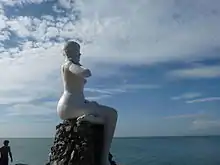Yeay Mao
Yeay Mao or Lok Yeay Mao (Khmer: យាយម៉ៅ - លោកយាយម៉ៅ, Grandma Mao) is an ancient mythical heroine[1] and a divinity in the local popular form of Buddhism and Brahmanism in Cambodia. She is venerated mainly is in the coastal provinces of the country, especially along the road from Phnom Penh to the sea port of Sihanoukville, as well as in Kampot and Kep. At the Bokor Mountain in Kampot there is a 29 meters tall monument to Yeay Mao inaugurated in 2012, while there is a young version of Yeay Mao in the Kep Beach called Beautiful Lady (ស្រីស្អាត) or Sela waits for her husband (សិលាចាំប្តី), but that belongs to the legend of Mao looking to the west for her lost husband. She is considered the protector of travelers and hunters. Drivers still stop at her shrine along National Road 4 near Phnom Pech Nil to pay their respects and wash their cars with water from the stream nearby, as well as the monument at Bokor.

History
The history of Yeay Mao is unclear, being composed of several legends and interpretations. There are many popular stories surrounding her. It is said that she was a beautiful lady married to a powerful warrior. When he died, she took control of the armies against the Thai and became a celebrity. The story is placed sometime before the French Colony (1863–1953).
Another version says that Yeay Mao was the wife of Ta Krohom-Koh (តាក្រហមក) - literally "Grandpa Red Neck". They lived in the forest near Pech Nil Mountain (ភ្នំពេជ្រនិល). Once they went around and they met a tiger. Ta Krohom-Koh abandoned his wife and the tiger devoured her.
Since then, any traveller who passed by the place of the accident, paid respect to her spirit to avoid a similar fate.[2]
When they built the highway between Phnom Penh and the sea in what is today Sihanoukville, a small temple was built at the spot. The road was finished by the French in 1876, a fact that increased the pilgrimage to the temple. It included Vietnamese and Chinese believers.
Celebration

The main feast is celebrated in June. The believers go to the Temple or any place destined for the veneration, to bring sacred food, especially pig head, chicken soup, the sla-thoa (ស្លាធម៌) - a coconut adorned with flowers and leaves and used in religious celebrations in Cambodia, the bay-sei (បាយសី)- section of banana tree trunk with legs to which three to nine layers of banana leaves rolled up in finger shape have been attached. It is used also in certain ceremonies. .[3]
The place of the veneration must be set with three statues:
- Yeay Sau (យាយសៅរ៍): A female spirit, that is the wife of Ung (អ៊ុង), the kaporal thnol (កាប៉ូរ៉ាលថ្នល់), guard of the paths.
- Ta Snong Long (តាស្នងឡុង): "Grandpa Snong Long", considered the son of Yeay Sau and Ung.
- Long Mao: She is the same "Yeay Mao".
Beliefs
According to Seik Sopat and Sadang Tuo,[4] the story of Yeay Mao dates from 1866, when she was a spirit of cruelty that attacked any traveller that did not pay respects to her at Pech Nil Mountain (ភ្នំពេជ្រនិល).
If the person to whom the spirit sent strong pains because ignoring to pay veneration to her, repented, that person was healed. But if that person did not repent, he or she could die.
It was also believed that if a person presented his offering asking to hurt an enemy, the spirit used to fulfil the wish.[5]
In 1900, the French army destroyed the first temple and the divinity came in decadence.
During the short Japanese invasion of Cambodia in 1940, the army of that country gathered the farmers of Kampot Province and Vietnamese, Chinese and Cham Cambodians, to dig trenches at the ancient sacred place. According to the legend, the workers desecrated the site, bringing the fury of the spirit. People started to suffer epidemics and many died. They explained these epidemics as the fury of Yeay Mao.[6]
In order to placate the spirit, the people started again to offer gifts to Yeay Mao and the veneration revived. After the villages near to Pech Nil Mountain, pray to the divinity asking for health and protection. If there was, for example, a theft, they pray to the spirit to punish the criminal.[5]
References
Notes
- Khmer Heroes, Kampuchea Krom Community: Yeay [or Grandma] Mao, visitors travel to seacoast Sihanoukville and Kampong Som province must stop to pay respect.. Link retrieved on 2nd Feb 2009.
- Seik Sopat y Sadang Tuo: Colección de Tradiciones Camboyanas (ប្រជុំរឿងព្រេងខ្មែរ), pp.82-83.
- Seik Sopat and Sadang Tuo: Collection of Cambodian Traditions (ប្រជុំរឿងព្រេងខ្មែរ), pp.80-81.
- Seik Sopat and Sadang Tuo: Collection of Cambodian Traditions (ប្រជុំរឿងព្រេងខ្មែរ), p.78.
- Seik Sopat and Sadang Tuo: Collection of Cambodian Traditions (ប្រជុំរឿងព្រេងខ្មែរ), p.80.
- Seik Sopat and Sadang Tuo: Collection of Cambodian Traditions (ប្រជុំរឿងព្រេងខ្មែរ), p.79.
Further reading
- Collection of Cambodian Traditions (ប្រជុំរឿងព្រេងខ្មែរ), Phnom Penh, 2001, Ministry of Education, Kingdom of Cambodia, pp 78–81.
External links
| Wikimedia Commons has media related to Yeay Mao. |
- The World of Spirits, gmc missions, 7 January 2009.